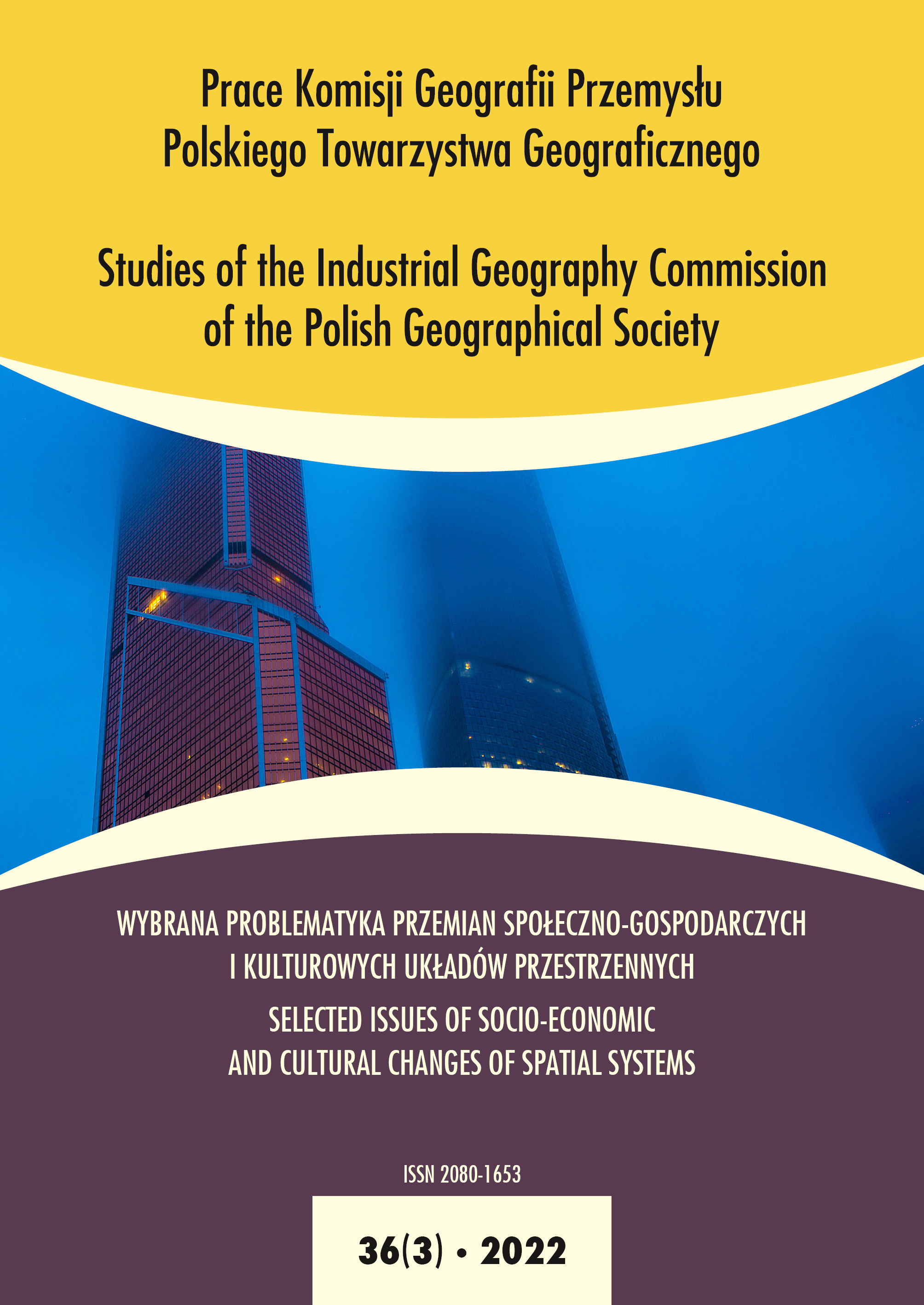The major stages in the development of a regional centre. The case of Pécs (Hungary)
DOI:
https://doi.org/10.24917/20801653.363.3Keywords:
development path, Hungary, Pécs, regional centreAbstract
The aim of the study is to provide an overview of the main milestones in the development of a regional centre in Hungary. Pécs is a centre of a depressed region. The Transdanubian region is among the 20 most disadvantaged regions of the European Union which shows a significant decline compared to previous years. This justifies the need for professional research directed at changing this situation by performing some tangible efforts. Pécs is a 2,000-years old city, acquiring various historical and mutually reinforcing central functions, by virtue of which it has developed into a regional centre. Of the historical drivers of the development of Pécs, the study is able to identify three groups of factors 1) centrality within its region, the regional functions it has fulfilled throughout its history, 2) culture and multiculturalism, and 3) industrial development. This study will analyse the relation of the cultural centre position and the other function of Pécs. The study is the first descriptive result of a research project1 that reviews the development and governance characteristics of a typical case of peripheral regions. Ongoing empirical analysis will allow the development of a development policy concept.
Downloads
Metrics
References
Budget of Pécs, 2020. Pécs Megyei Jogú Város Önkormányzata Közgyűlésének 6/2020. (III. 12.) önkormányzati rendelete a Város 2020. évi költségvetéséről. Retrieved from: https://net.jogtar.hu/rendelet?docid=A2000006.PEC&dbnum=530&council=pecs (Accessed on: 28.11.2021).
DDRFÜ Nonprofit Kft. (2013). Pécs a befogadó város, küzdelem a szegénység és a társadalmi kirekesztés ellen. Stratégiai koncepció 2014–2020.
Eco-Cortex–MSB (2014a). Pécs Megyei Jogú Város Fejlesztési Koncepció 2014–2030. Pécs. EcoCortex Kft. – MSB Zrt.
Eco-Cortex–MSB (2014b). Pécs Megyei Jogú Város Integrált Településfejlesztési Stratégiája 2014–2020. Pécs. Eco-Cortex Kft. – MSB Zrt.
Egyed, I., Rácz, Sz. (2020). The role of territorial capital in urban renewal in a non-core Central European city. Deturope, 12(3), 108–132.
Erdősi, F. (2018). Pécs ellentmondásos fejlődésének energiái és stációi. előadás. 2018. március 28. Pécs; MTA KRTK RKI DTO szeminárium.
Faragó, L. (2010). Pécs fejlődési pályája – Egy pécsi polgár szemével. TERÜLETFEJLESZTÉS ÉS INNOVÁCIÓ 4. 2–14.
Faragó, L. (2011). Az Európai Kulturális Fővárosa program városfejlesztési, városirányítási tanulságai. In: Elemző értékelés a Pécs2010 EKF Program tapasztalatairól. PMJV, Pécs. 61–74.
Fehér, Sz. (2007). Társadalmi tőke és egészségi állapot Pécsbányatelepen. Acta Sociologica, III, 41–56.
Füzér, K. (2016). A társadalmi tőke fel-és elhasználása városfejlesztési folyamatokban. elitek, kirekesztettek és a projektosztály az ezredforduló utáni Pécsett. előadás. MRTT XIV. Vándorgyűlés, Nagyvárad.
Füzér, K. (2017). A projektesített város. Részvételi városfejlesztés az ezredfordulós Pécsett. Pécs: Rublikon kiadó.
Hajdú, Z. (2001). Magyarország közigazgatási földrajza. Budapest–Pécs: Dialóg Campus Kiadó.
IUDS. (2013, 2020). PMJV Integrált Településfejlesztési Stratégiája 2014–2020 and 2013.
IUKS. (2016). PMJV Tudásmenedzsment Stratégiája, 2016.
Kaposi, Z. (2006). Pécs gazdasági fejlődése 1867–2000. Pécs-Baranyai Kereskedelmi és Iparkamara, Pécs.
Kaposi, Z. (2007a). Pécs mezőgazdasági rendszere a dualizmus korszakában. In: Z. Kaposi, M. Pilkhoffer (ed.), Tanulmányok Pécs történetéből 19. Pécs: Pécs Története Alapítvány, 101–126.
Kaposi, Z. (2007b). Iparszerkezeti változások Pécsett a gazdasági reform leállításától a rendszerváltásig terjedő időszakban (1972–1990). In: Z. Kaposi, M. Pilkhoffer (ed.), Tanulmányok Pécs történetéből 19. Pécs: Pécs Története Alapítvány, 155–178.
Kaposi, Z. (2018). Pécs történelmi távlatai. előadás. 2018. március 28. Pécs: MTA KRTK RKI DTO szeminárium.
Koltai, Z. (2007). A magyarországi városok versenyképességének vállalati megítélése. Tér és Társadalom, 2, 23–42.
Lengyel, I., Rechnitzer, J. (2004). Regionális gazdaságtan. Pécs–Budapest: Dialog Campus Kiadó.
Lux, G. (2021).Manufacturing in the post-industrial city: the role of a “Hidden Sector” in the development of Pécs, Hungary. In: J. Kunc, W. Cudny (ed.). Growth and Change in Post-socialist Cities of Central Europe. London: Routledge, 94–112.
Mezei, C. (ed.). (2017). Az önkormányzatok reális gazdaságélénkítési lehetőségeinek kutatása. KÖFOP-2.3.3-VEKOP-16-2016-00001 HVK research program.
Mezei, K. (2005). A PTE hatása Pécs város gazdaságára. In: Gy. Enyedi, K. Keresztély (ed.), A magyar városok kulturális gazdasága. Budapest: MTA Társadalomkutató Központ, 143–178.
Móró, M.A. (1995). Pécs népessége a török alóli felszabadulástól 1848-tól. In: J. Vonyó (ed.), Tanulmányok Pécs történetéből I. Pécs: Pécs népessége, 1543–1990.
Myrdal, G. (1957). Economic theory and under-developed regions. London: Duckworth.
Nagy Kalamász, I. (2007). A társadalmi részvétel és a tudáshasználat. In: I. Kovách (ed.), Vidékiek és városiak. A tudás – és imázshasználat hatásai a vidéki Magyarországon. L’Harmattan MTA PTI.
Németh, Zs. (1995). Pécs népességének főbb demográfiai és társadalmi jellemzői a második világháború befejezésétől 1990-ig. In: J. Vonyó (ed.), Tanulmányok Pécs történetéből 1. Pécs: MTT, 117–160.
Pálné Kovács, I. (2021). A centralizáció és a perifériák fejlődési esélyei. Tér és Társadalom, 35(4), 215–240. doi: https://doi.org/10.17649/TET.35.4.3372
Rokkan, S., Urwin, D.W. (1983). Economy, Territory, Identity: Politics of West European Peripheries. London: SAGE Publications.
Sitányi, L., Ludescher, G. (2009). Az innováció és a társadalmi tőke kapcsolata a Pécsi Tudományegyetem példája alapján. Területfejlesztés és Innováció, 3, 10–18.
Zarycki, T. (2000). Politics in the periphery. Political cleavages in Poland Interpreted in their Historical and International Context. Europa-Asia Studies, 52(5), 851–873.
Trócsányi, A. (2006). Pécs városszerkezetének változása, a kulturális főváros projekt térformáló hatásai. In. Kertész, Á., Dövényi, Z., Kocsis, K. (eds.). III. Magyar Földrajzi Konferencia. Budapest: MTA FKI, 238–250.
Wallerstein, I.M. (1974). The modern world-system. New York: Academic Press.
www.bama.hu/gazdasag/helyi-gazdasag/majdnem-felezer-munkahelyet-hoz-letre-pecsett-egy-del-koreai-autoalkatreszgyarto-1594744/ (Accessed on: 28.11.2021).
www.ceginformacio.hu (Accessed on: 28.11.2021).
www.hauni.hu (Accessed on: 28.11.2021).
www.hirado.hu/2017/09/07/tenyfeltaro-bizottsag-alakul-a-pecsi-onkormanyzat-adossaganak-vizsgalatara/ (Accessed on: 28.11.2021).
www.okpecs.hu/siman-johetett-volna-pecsre-bmw-de-miert-nem-jott/ (Accessed on: 28.11.2021).
www.pecs.hu (Accessed on: 28.11.2021).
www.pte.hu (Accessed on: 28.11.2021).
Downloads
Published
How to Cite
Issue
Section
License
Copyright (c) 2022 Studies of the Industrial Geography Commission of the Polish Geographical Society

This work is licensed under a Creative Commons Attribution-NoDerivatives 4.0 International License.
Articles are published under the terms of the Creative Commons License (CC BY-ND 4.0; Attribution– NoDerivs).

